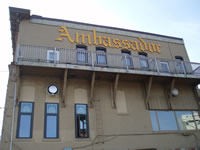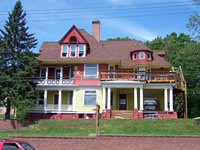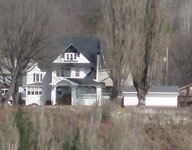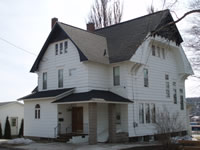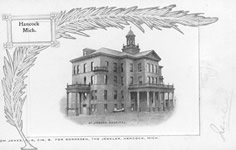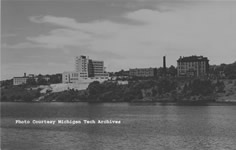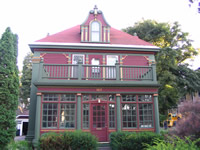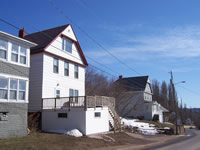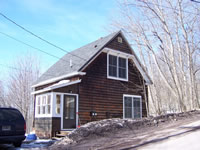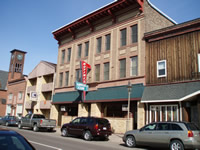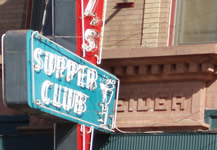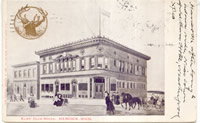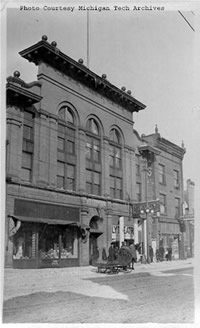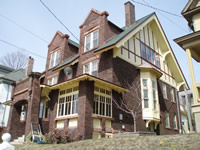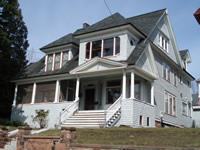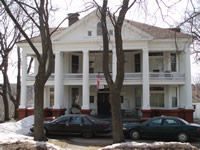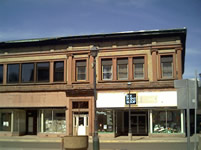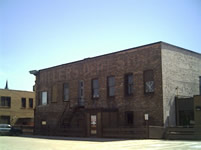Bosch Building This brick and stone building was constructed by 1901, when Napoleon Carpentier ran a saloon here. He sold to the Bosch Brewing Co. in 1904 and this became a Bosch saloon run by Henry Feldman.7 The two-story brick building has been heavily modified on the first floor, where most of the sandstone is now hidden by a 1950s-era brick entrance. The original entrance on the right side was right at the corner, and was accented with its own Luxfer Prisms. The building’s layout was nearly identical to that of the Schneider building in Hancock, a two-store first floor, and an identical second-floor apartment layout. The Bosch Building was much fancier than the Schneider building. While they both had original sandstone-block first floors and pilasters around their doors, the Schneider building used regular bricks from the second floor and up. The Bosch Building has cut stone pilasters separating every window on the second floor that faces the street, as well as sandstone beltcourses. Also, just below the cornice are the same brick panels seen in the Schneider building.8 The rear of the building looks as though it has been painted, but the segmented-arched windows that also are in the Schneider building drawing are still visible. This building is now home to the Ambassador Bar and Grill.
J. E. Scallon House This rambling house has an irregular roofline, projections and recessions, bay windows, dormers of different shapes, and porches. Located on the far west side of Hancock, this house was built for Dr. J. E. Scallon. It was planned in 1901, and was to be one of the “costly and elegant” houses in Hancock. The newspaper described it as a “modern colonial type” and noted its porte cochere and Portage Entry sandstone foundation. The reception hall had paneled wainscoting and ceiling, as well as a fireplace and seats. The parlor, living room and dining room were reached through sliding doors. There were five bedrooms on the second floor and one on the first. The front part of the attic “will be fitted up for a banquet hall to be used for private parties.” This five-bedroom dwelling was to have all the modern fixtures; it is said that Liebert took extra care in developing the heating and ventilation systems.9 Whittle House Thomas Whittle, chief mining captain for the Quincy Mining Company, purchased this property and had two houses removed from it and placed at the top of Vivian Street. The house was built as a wedding gift for his wife, Lylie. The two-and-a-half-story house had a cross-gabled roof with projections in the peaks of the gables. Various porches, bay windows, and a variety of fenestration lend a Queen Anne-style feel the house. The interior is trimmed with red oak and Georgia pine, and all of the fixtures were from Tiffany. The front of the house overlooks the Portage Canal and was featured in the June 1979 edition of National Geographic.10 The arch supports under the overhangs are similar to those under the eaves of Liebert’s own home.
St. Joseph's Hospital St. Mary's Hospital was established in 1896 in Bishop John Vertin's family home in Hancock. In 1903 construction started on this hospital building, which adopted a new name, St. Joseph's. The imposing three-story structure contained operating rooms, wards for patients, a sterilizing room, an etherizing room, a chapel, living quarters for the Sisters of St. Joseph, and an elevator. The building promoted its modernity and sanitary qualities, such as the marble wainscoting, enameled white walls, and curved corners of the sterilizing room. The building was equipped with both electricity and gas for lighting, as well as "the most modern system of sanitary plumbing and ventilation." Contemporary thinking about ventilation also prevailed: "The corridors on the first, second and third floors present magnificent walks for the convalescent patients. They are roomy and well lighted and on the two lower floors they terminate in balconies intended as places of rest and fresh air for the convalescents." The hospital attempted to provide for the wealthier patients: not only were there rooms for two beds, there were single rooms as well. "On the second floor are the private rooms, large, airy, each with one bed. Here the private patients will be treated. On the second floor there is also one elegant suite of rooms intended for the use of such patients as may desire more luxury than the ordinary person can afford."12 The brick building measured 105 by 70 feet and cost about $100,000 to construct. The sandstone basement contained a full story, which held the emergency room. Ambulances unloaded patients under the porte-cochere on the east side. Porticos on front and rear also decorated the building and rounded corners on the east side were topped with balconies above the second level. The hipped roof had a cross gable on the east side; at the center of the roof was distinctive cupola, rising 110 feet from the ground.11 A stone passageway connected the hospital to the laundry and heating plant. This 60' x 30' building housed the heating plant on the first level, with an 80'-high smoke stack. The hospital laundry was on the second level. In 1920 St. Joseph's School of Nursing was established. A three-story brick nurse's residence was added to the complex in 1930. In 1950 a new seven-story, International Style hospital was constructed. The nursing school moved into the old hospital, which was then called Ryan Hall. The nursing school was dissolved in 1975 and the old hospital demolished a decade later. St. Joseph's Hospital took on a new name, Portage View, the next year and became the Portage Health System in 1995. In 2000 the hospital moved to a new facility on Quincy Hill.
Dickens House This house displays a Colonial Revival style in a four-square form with a tall hip roof. The tall dormer windows are decorated with scroll pediment and pilasters flanking round-arched windows. There are two-story pilasters on the outer corners of the main block and smaller pilasters separating the second-floor windows. The one-story porch across the front is enclosed with glass and columns, and is topped by a balustrade. Liebert’s drawings, in possession of the homeowner, are dated 1902, but Milton R. Dickens and his wife were not listed at this address until 1905. Milton’s mother, Helen M. Dickens, lived with Milton and his wife, Henrietta. Milton Dickens was a clerk for the Shelden estate. Houses for Quincy Mining Company Liebert designed two types of houses for Quincy to build and sell to the public in its newly platted Quincy Second Hillside Addition. The smaller form (the first three listed) was 1 ½ stories with a large entrance hall, two rooms on the first floor and two bedrooms on the second floor. The larger version (the second three listed above) were 2 ½ stories with an additional room on the first and second floors, as well as a bathroom. Both types were clad in shingles and had a distinguishing ornament in the peak of the gable.13
Schneider Building Contractor: Herman Gundlach This three-story brick building was constructed for Joseph Schneider of 317 Harris St., East Hancock, who owned a saloon on the first floor. The first-floor storefronts have been altered; the drawings indicate they would have been sandstone. The second and third stories have four bays of paired windows, with raised brick panels on the spandrels between the stories. The strong cornice has dentils, modillions, and brackets with raised brick panels on the frieze between the brackets. The newspaper noted: “The structure is not only well constructed but is also modern in every respect and the arrangement is all that could be desired by those looking for comfort and convenience.” 14 The first floor was a side-by-side two-store layout.15 The store at 321 Quincy was home to the Schneider Saloon; 319 was the location for Frank James insurance Agency. The second and third floors held identical apartment layouts. Entering the stairs from the center of the building, going left or right brought you into identical (mirrored left to right) apartments. They have two bedrooms in the back, then a bathroom, in front of that is a kitchen with an elaborate pantry, seen also in the Bosch Building apartments. Each pantry has two floor-to-ceiling sets of shelves, a bread box and flour bin. Liebert seems to have put quite a bit of attention into these, as they usually take up at least half a page in his plans. Beyond the pantry was a living room and a parlor separated by an arched doorway. This building is now the home to Nutini’s Supper Club, but the name Schneider still appears above the entrance, in the sandstone belt course behind the Supper Club sign.
Elks Club Hancock’s Elks Club contracted for a two-story brick building with a rounded corner, elaborate cornice, and decorative molding over the second-floor windows. The basement was left unfinished, but was planned to accommodate bowling alleys or gymnasium, as well as the furnace. Commercial storefronts occupied the first floor, providing an income to the Elks. The second floor contained their lodge room with stage, as well as a library, private dining room, reception hall, billiard room, and kitchen. Oak woodwork adorned the rooms, including a 7’-high wainscot with plate rail and a beamed ceiling in the private dining room and a 3-1/2’-high wainscot and beamed ceiling in the library. The newspaper lauded the site: “The corner on which the structure will be erected is considered one of the best in the city and the fact that a magnificent building will be erected there by the ‘Best People on Earth’ is also pleasing.”16 This last quote was a reference to B.P.O.E., or the Elks’ formal name, Benevolent and Protective Order of Elks.
Germania Hall The German Aid Society, which claimed to be "the oldest society in copperdom," was formed in 1859 by forty-men who worked at the Quincy Mining Company. Besides its social function, the organization was also a benevolent society, providing aid for sick and disabled members and to the wives and children of deceased members. In 1873, the society built the first Germania Hall, which at the time was the largest building in Hancock. By the 20th century, that building was inadequate so the society tore it down and built this new building on the same site.18 It is not surprising that the German Aid Society would turn to the German-born Leibert to design this building. The brick building with sandstone trim measured 60' x 135'. The first floor was divided into two stores, a mezzanine level contained a banquet hall, kitchen, and janitor's quarters, and the third floor had a large hall, with a floor space of 57' x 80' plus a stage and gallery. The hall was marked on the exterior by three tall round-arched windows, each the equivalent of three stories high. The hall was lit with six arc lamps and decorative lights.19 A prominent cornice crowned the building. When the building was destroyed by fire in 1966 it was known as Lincoln Hall and was serving as a teen center.20
Liebert House Hans Liebert designed and built his house about 1907.21 Several Jacobean Revival features are contained in a bungalow form in this house. The brick walls, parapeted gable wall dormers, portcullis-like entrance, and half-timbering in the gable are all elements of the Jacobean Revival, while the broad gable roof, deep bracketed eaves, and oriel with stained glass are hallmarks of the bungalow. Liebert owned this house until 1912, and might have stopped living in it as early as 1910.
Lawton House This bungalow-style home was originally built for Swaby and Lucy Lawton. Swaby was a lawyer for Hanchette & Lawton and brother of Quincy Mining Company's general manager.22 The side-gable roof is a prominent feature, extending to cover the porch across the front. There are two large hip-roofed dormers in front of different sizes, although the one on the right may have originally been an open porch. There is a bay window on the first-floor front. The walls are wood-shingled.
Kauth House A two-story porch with two-story fluted columns and a prominent pedimented portico distinguish this house, which also has two-story bay windows flanking the central entrance. Andrew Kauth, owner of the Kauth Block and a fine upscale saloon, had this foundation dug and laid a couple years ahead of time in order to let it settle before a house was to be built.23 This Classical Revival-style house has a two-story porch across the front, with a two-story portico in front of it. The columns are Doric and there is a Palladian window in the pediment. The interior was richly appointed, with quarter-sawn oak and curly birch woodwork, parquet floors, panel wainscotings and panel beam ceilings in the reception hall and main rooms, “the latest sanitary plumbing, with all porcelain fixtures,” clothes presses in the bedrooms, and a linen closet in the second-story hall.24 220-224 Shelden This is Liebert’s third business block in the area and is similar to his others, arranged for two stores and apartments above. This building has been changed in many ways. Some of the first-floor sandstone still exists, mostly on the western storefront and the apartment entrance. The second floor has stone pilasters in the Ionic form and more plain-looking ones separating the banded set of three windows. The windows set on the right appear to be the original, and the left has been replaced with newer ones, although some attempt was taken to reuse the cut stone pilasters that surrounded the original windows. Also, there is a center window over the apartment entrance, and the single window at the corner. This suggests that this might not have the same apartment layout of the Schneider and Bosch building. Just below the cornice, the building shows the same style of brick panels seen on the Schneider and Bosch Buildings. This could have been the home to Miller’s Department Store, as the words still barely appear on the back of the building.
|




